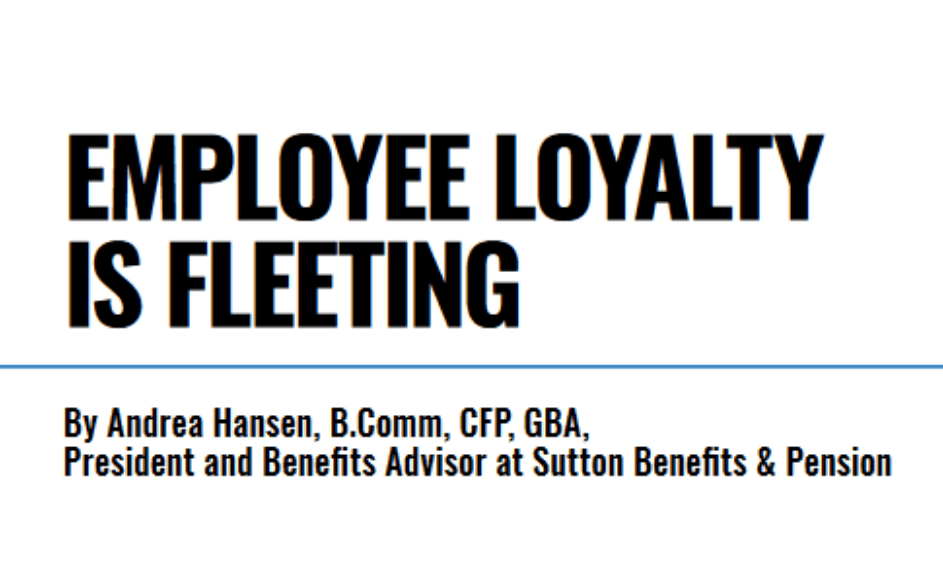As COVID-19 subsides, we are seeing the predicted “turnover tsunami” emerge. The Canadian Workplace Culture Index recently conducted a survey that revealed 77 per cent of employees in the Prairies would leave their job for the same position at another company for a 10 per cent raise. The same study showed that 96 per cent like the people they work with and 91 per cent like where they work1. So why would the majority leave their job for a 10 per cent increase in pay?
 The pandemic has been unpredictable. There has been economic uncertainty, food insecurity, and isolation. Most of us have missed out on experiences and life milestones, like graduations, weddings, and funerals. We have been cut off from hobbies or favourite activities, and we have been required to follow safety protocols that take extra care and effort. We are experiencing financial, emotional, and mental stress, and many factors have felt out of our control. So, we focus on things we can control. And when financial stress is a factor, taking a job for 10 per cent more pay can seem attractive.
The pandemic has been unpredictable. There has been economic uncertainty, food insecurity, and isolation. Most of us have missed out on experiences and life milestones, like graduations, weddings, and funerals. We have been cut off from hobbies or favourite activities, and we have been required to follow safety protocols that take extra care and effort. We are experiencing financial, emotional, and mental stress, and many factors have felt out of our control. So, we focus on things we can control. And when financial stress is a factor, taking a job for 10 per cent more pay can seem attractive.
WHAT CAN EMPLOYERS DO TO SUSTAIN LOYALTY?
The 2021 Manulife Canada Retirement Study on stress, finances, and well-being revealed intriguing statistics – and the “stress paradox”. The financial position of Canadians has improved, but stress has worsened! Overall, Canadians’ disposable income rose 10.8 per cent in the early part of the pandemic with a decline of 13.7 per cent in spending and an average household net savings of $10,507. Yet twice as many people reported general or financial stress during the pandemic, compared to before the pandemic. Half the respondents said they felt stressed often and four in 10 said their state of mental health interferes with their ability to work. “70 per cent said they would be more productive at work if financial worries did not intrude.”
Half the respondents said they felt stressed often and four in ten said their state of mental health interferes with their ability to work. “70 per cent said they would be more productive at work if financial worries did not intrude.”
Not knowing the right investments to make, how much to save for retirement, what is needed for an emergency fund, or how to reduce debt are just a few examples of the knowledge gap that is driving a lot of that tension and stress. It makes sense that “80 per cent say having a retirement plan is a critical company benefit” and “60 per cent report they would be unlikely to work for a company that doesn’t provide one”2. But the key component for minimizing financial stress, helping employees feel more confident about their future, and sustaining employee loyalty is pairing the group retirement savings plan (GRSP) with financial planning education.
“An investment in knowledge pays the best interest.”
— Benjamin Franklin
THREE QUICK WINS TO EMPOWER EMPLOYEES AND EASE FINANCIAL STRESS
1. Educate your employees about the tax benefits of GRSPs and provide an opportunity for them to contribute their year-end bonus to their savings plan.
2. Offer more choices so your employees can control how they use their benefit dollars. Flex accounts allow employees to allocate their spending among three buckets: health expenses, eligible wellness expenses, and retirement savings.
3. Match employees’ student debt repayment with contributions to a GRSP. For many graduates, student debt can be a barrier to saving. By matching what they pay on their student debt, you are investing in their financial future – and building loyalty.
CONNECTING THE DOTS
Through an intentionally designed group benefits and pension plan, employers can ease financial stress,empower employees, and support overall wellbeing. The value of providing employees with peace of mind will be far greater than a 10 per cent raise in pay. By taking a proactive and holistic approach to total rewards, employers can buck the trend revealed by the Canadian Workplace Culture Report and perhaps create a new title for it. I imagine that new title would be something like Employee Loyalty on the
Prairies is Growing.
First published in the April 2022 edition of The Potash Producer.
REFERENCES
1 Canadian Workplace Culture Index/ Angus Reid Institute. 2021 Canadian Workplace Culture Report. CWCI, 2021.
2 Manulife Investment Management/John Hancock Retirement/Greenwald & Associates. 2021 Manulife Canada Retirement Study: Stress, Finances, Well-Being. Manulife, 2022.


